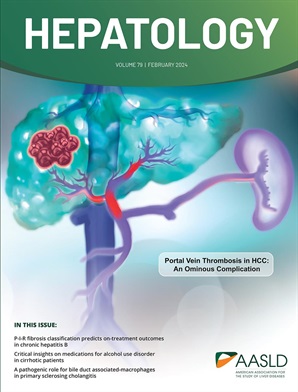Multiomics approaches for identifying the PANoptosis signature and prognostic model via a multimachine-learning computational framework for intrahepatic cholangiocarcinoma
IF 12.9
1区 医学
Q1 GASTROENTEROLOGY & HEPATOLOGY
引用次数: 0
Abstract
Background & Aims: The aims of the present study were to characterize the PANoptosis signature in intrahepatic cholangiocarcinoma (ICC) patients, construct a novel model to guide clinical diagnosis and treatment, and further explore the associated molecular mechanisms of drug resistance. Approach & Results: In total, 85 PANoptosis-related genes that possess both PANoptosis and multiomics features were respectively screened from transcriptomic data from the OEP001105 public cohort and from transcriptomic and proteomic sequencing data from The First Affiliated Hospital of Chongqing Medical University. A novel framework integrating Cox regression analysis and five machine learning algorithms was developed to identify the five hub genes (POSTN, SFN, MYOF, HOGA1, and PECR), The subsequently constructed PANoptosis risk score (PANRS) demonstrate outstanding performance in predicting prognosis and clinical translation across multicenter cohorts with multiomics profiling. Bulk and single-cell transcriptome profiling were used to investigate the tumor microenvironment (TME), emphasizing the crucial role of macrophages in the TME of ICCs. Moreover, a positive spatial correlation of CAFs-derived POSTN expression with TAMs infiltration and PD-L1/PD-L2 expression in ICC patients was observed, suggesting that overexpression of POSTN may lead to resistance to ICB therapy in ICC patients. Conclusion: The present study identified a precise prognostic and treatment strategy for ICC patients prone to PANoptosis, investigated the molecular mechanisms of PANoptosis in ICC cells, and highlighted the potential clinical relevance of the PANRS in predicting prognosis and therapy response. These findings will help guide clinical treatment strategies for ICC.通过多机器学习计算框架识别肝内胆管癌PANoptosis特征和预后模型的多组学方法
背景,目的:本研究旨在表征肝内胆管癌(ICC)患者PANoptosis特征,构建指导临床诊断和治疗的新模型,并进一步探讨其耐药的相关分子机制。的方法,结果:从OEP001105公共队列的转录组数据和重庆医科大学第一附属医院的转录组和蛋白质组测序数据中,共筛选出85个同时具有PANoptosis和多组学特征的PANoptosis相关基因。研究人员开发了一种新的框架,将Cox回归分析和五种机器学习算法结合起来,以识别五个中心基因(POSTN、SFN、MYOF、HOGA1和PECR)。随后构建的PANoptosis风险评分(PANRS)在多中心队列多组学分析中预测预后和临床翻译方面表现出色。利用整体和单细胞转录组分析来研究肿瘤微环境(TME),强调巨噬细胞在ICCs TME中的关键作用。此外,在ICC患者中观察到cafs来源的POSTN表达与TAMs浸润和PD-L1/PD-L2表达呈正空间相关性,表明POSTN过表达可能导致ICC患者对ICB治疗产生耐药性。结论:本研究确定了易发生PANoptosis的ICC患者的精确预后和治疗策略,探讨了ICC细胞PANoptosis的分子机制,并强调了PANRS在预测预后和治疗反应方面的潜在临床意义。这些发现将有助于指导ICC的临床治疗策略。
本文章由计算机程序翻译,如有差异,请以英文原文为准。
求助全文
约1分钟内获得全文
求助全文
来源期刊

Hepatology
医学-胃肠肝病学
CiteScore
27.50
自引率
3.70%
发文量
609
审稿时长
1 months
期刊介绍:
HEPATOLOGY is recognized as the leading publication in the field of liver disease. It features original, peer-reviewed articles covering various aspects of liver structure, function, and disease. The journal's distinguished Editorial Board carefully selects the best articles each month, focusing on topics including immunology, chronic hepatitis, viral hepatitis, cirrhosis, genetic and metabolic liver diseases, liver cancer, and drug metabolism.
 求助内容:
求助内容: 应助结果提醒方式:
应助结果提醒方式:


